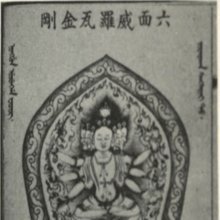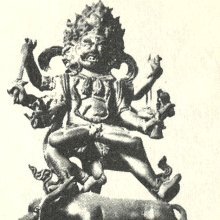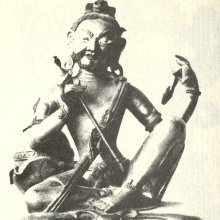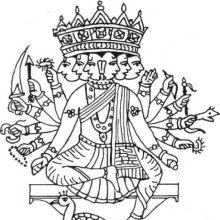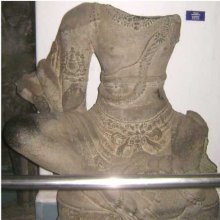Shanmukha, Ṣaṇmukha, Shash-mukha: 25 definitions
Introduction:
Shanmukha means something in Buddhism, Pali, Hinduism, Sanskrit, Jainism, Prakrit, Marathi, Hindi. If you want to know the exact meaning, history, etymology or English translation of this term then check out the descriptions on this page. Add your comment or reference to a book if you want to contribute to this summary article.
The Sanskrit term Ṣaṇmukha can be transliterated into English as Sanmukha or Shanmukha, using the IAST transliteration scheme (?).
Alternative spellings of this word include Sanmukh.
Images (photo gallery)
(+7 more images available)
In Hinduism
Shilpashastra (iconography)
Source: Wisdom Library: Elements of Hindu IconograpyṢaṇmukha (one of the aspects of Subrahmaṇya, according to the Kumāra-tantra). The colour of Ṣaṇmukha should be that of kuṅkuma (saffron) and he should be seated on the peacock. As his name indicates he should have six faces, twelvy eyes and twelve arms; in the right hands he should have the śakti, bāṇa, the khaḍga, dhvaja, gadā and abhaya; and in the left ones dhanus, vajra, padma, kaṭaka-hasta and varada (and one more object which is perhaps the kheṭaka). Ṣaṇmukha is here mentioned as the nephew of Viṣṇu. The Śrītatvanidhi mentions the śaṅkha, chakra, kukkuṭa, pāśa and hala as among the objects held by the hands of Ṣaṇmukha. It als states that on either side of Ṣaṇmukha there should be standing two devīs called Jayā and Vijayā.
Source: archive.org: Catalogue of Pancaratra Agama Texts (shilpa)Ṣaṇmukha (षण्मुख) refers to one of the Parivāra-Devatās (“attendant deities”) according to chapter 22 (Kriyāpāda) of the Padmasaṃhitā: the most widely followed of Saṃhitā covering the entire range of concerns of Pāñcarātra doctrine and practice (i.e., the four-fold formulation of subject matter—jñāna, yoga, kriyā and caryā) consisting of roughly 9000 verses.—Description of the chapter [parivāra-vidhi]: Iconometry continues, this chapter being given over to rules for the attendant deities [parivāra-devatā]: [e.g., Ṣaṇmukha] [...]. Then the discussion turns to the vehicles of the gods, namely Brahmā’s Swan and Rudra’s Ox, etc. (61b-64).
Source: Red Zambala: Hindu Icons and Symbols | Inner Circle IVAs Ṣaṇmukha (or Subrāmaṇya) Murugan is married to two wives:—
- Valli (“the earth”), who represents the casual or informal means of progress and growth.
- Devasenā (“army of the gods”) or Devakunjari (“divine celestial elephant”) — these names are suggestive of ability and power of action.
Ṣaṇmukha (or Sanmukhan) is the name of deity as found depicted in the Subramanya Swamy Temple (or Subrahmaṇya Svāmi Temple) in Tiruchendur (or Tirucendur/Tirucentur), representing a sacred place for the worship of Murugan.—Ṣaṇmukha is found in samabhaṅga pose with six pairs of hands. A vel is placed in the right hand and the corresponding left hand is in varada. Valli and Deivānai are found on either side of the god. To the right of the main sanctum, there is the sannidhi for Murukan where he is found in standing posture. In front of this sannidhi there are images of a crow, a peacock and a Nandi.
Ṣaṇmukha is also depicted in the Subramanya Swamy Temple (or Subramaṇya Svāmi Temple) in Thiruparankundram or Parankundram (Paraṅkuṉṟam), another a sacred place for the worship of Murugan.—Ṣanmukhan (Ṣaṇmukha) is found with six heads and six pairs of hands in standing posture. Valli and Deivānai are found on the two sides of Ṣaṇmukha. Peacock is not seen in this sannidhi. In general, the emblems fitted to the hands of Ṣaṇmukha are twenty six in total. They are (i) Four mudrās: abhaya, varada, urū and kaṭi; (ii) Fifteen weapons: śakti, vajra, śūla, khaḍga, ketaka, cakra, śaṅkh, aṅkuśa, tomara (an iron club or javelin), pāśa, bāṇa, dhanuṣ, halā and danḍa; (iii) Seven others: kukkuṭa, kukkuṭadvaja, sruva, japamāla, āranim, pūrṇakuṃbha, nīlōtpala, puṣpabāṇa and ikṣucāpa (sugarcane bow). In dance, Ṣaṇmukha is represented in sama śiras and samapāda-sthānaka.

Shilpashastra (शिल्पशास्त्र, śilpaśāstra) represents the ancient Indian science (shastra) of creative arts (shilpa) such as sculpture, iconography and painting. Closely related to Vastushastra (architecture), they often share the same literature.
Purana and Itihasa (epic history)
Source: archive.org: Shiva Purana - English TranslationṢaṇmukha (षण्मुख) refers to “one who has six faces” and is used to describe Guha / Kārttikeya (i.e., Śiva’s son), according to the Śivapurāṇa 2.4.3 (“The boyhood sports of Kārttikeya”).—Accordingly, as Brahmā narrated to Nārada: “[...] Meanwhile the six ladies named Kṛttikās came there for bath and they saw the lordly boy [i.e., Guha / Kārttikeya]. All of them desired to take and fondle him O sage, as a result of their simultaneous desire for taking and fondling the boy, a dispute arose. In order to quell their mutual dispute, the boy assumed six faces (ṣaṇmukha) and drank milk off their breasts. O sage, they were all satisfied. [...]”.
Source: Cologne Digital Sanskrit Dictionaries: The Purana Index1a) Ṣaṇmukha (षण्मुख).—(Kumāra); anecdotes of, in the skāndapurāṇa;1 a leader in the battle of Tripuram;2 all the wives of the seven seers except Arundhatī served Kumāra as mothers. Hence the six-faced.3
- 1) Brahmāṇḍa-purāṇa III. 10. 42; Matsya-purāṇa 53. 42.
- 2) Ib. 136. 68; 137. 32; 159. 3; 160. 11 and 28.
- 3) Vāyu-purāṇa 72. 40.
1b) A name of Vighneśvara.*
- * Brahmāṇḍa-purāṇa IV. 44. 68.

The Purana (पुराण, purāṇas) refers to Sanskrit literature preserving ancient India’s vast cultural history, including historical legends, religious ceremonies, various arts and sciences. The eighteen mahapuranas total over 400,000 shlokas (metrical couplets) and date to at least several centuries BCE.
Ganitashastra (Mathematics and Algebra)
Source: archive.org: Hindu MathematicsṢaṇmukha (षण्मुख) represents the number 6 (six) in the “word-numeral system” (bhūtasaṃkhyā), which was used in Sanskrit texts dealing with astronomy, mathematics, metrics, as well as in the dates of inscriptions and manuscripts in ancient Indian literature.—A system of expressing numbers by means of words arranged as in the place-value notation was developed and perfected in India in the early centuries of the Christian era. In this system the numerals [e.g., 6—ṣaṇmukha] are expressed by names of things, beings or concepts, which, naturally or in accordance with the teaching of the Śāstras, connote numbers.

Ganita (गणित) or Ganitashastra refers to the ancient Indian science of mathematics, algebra, number theory, arithmetic, etc. Closely allied with astronomy, both were commonly taught and studied in universities, even since the 1st millennium BCE. Ganita-shastra also includes ritualistic math-books such as the Shulba-sutras.
Shaktism (Shakta philosophy)
Source: Google Books: ManthanabhairavatantramṢaṇmukha (षण्मुख) is another name for Skanda, according to verse 11.36-38 of the Kularatnoddyota, one of the earliest Kubjikā Tantras.—Accordingly, “When the (goddess) born in the family of the Himalaya will assume a body, Skanda (Ṣaṇmukha) will be her son. Then Mitreśa who is accompanied by his consort, will tell his consort the teaching of knowledge in a solitary place (but) will not tell (it) to (his) son. O fair lady, out of anger, his son Skanda will throw that book into the sea and a fish will swallow it”.

Shakta (शाक्त, śākta) or Shaktism (śāktism) represents a tradition of Hinduism where the Goddess (Devi) is revered and worshipped. Shakta literature includes a range of scriptures, including various Agamas and Tantras, although its roots may be traced back to the Vedas.
Pancaratra (worship of Nārāyaṇa)
Source: archive.org: Catalogue of Pancaratra Agama TextsṢaṇmukha (षण्मुख) (=Skanda) is the name of a deity for whom the Yāga (“worship and offering”) is discussed in chapter 1 of the Śivarātra section of the Sanatkumārasaṃhitā: an encyclopedic Sanskrit text written in over 3500 verses dealing with a variety of topics such as yoga, temple-building, consecration ceremonies, initiation and dhanurveda (martial arts).—Description of the chapter [tithi-yāga]: Sanatkumāra proposes to deal here briefly with tithiyāga concerns during the bright fortnight. [...] Then follow directions for the yāga of Ṣaṇmukha (=Skanda) and his attendants (118b-142a); [...]

Pancaratra (पाञ्चरात्र, pāñcarātra) represents a tradition of Hinduism where Narayana is revered and worshipped. Closeley related to Vaishnavism, the Pancaratra literature includes various Agamas and tantras incorporating many Vaishnava philosophies.
In Buddhism
Tibetan Buddhism (Vajrayana or tantric Buddhism)
Source: Wisdom Library: Tibetan BuddhismṢaṇmukhā (षण्मुखा) is the name of a Dhāraṇī Goddesses mentioned as attending the teachings in the 6th century Mañjuśrīmūlakalpa: one of the largest Kriyā Tantras devoted to Mañjuśrī (the Bodhisattva of wisdom) representing an encyclopedia of knowledge primarily concerned with ritualistic elements in Buddhism. The teachings in this text originate from Mañjuśrī and were taught to and by Buddha Śākyamuni in the presence of a large audience (including Ṣaṇmukhā).
Source: Brill: Śaivism and the Tantric Traditions (tantric Buddhism)Ṣaṇmukha (षण्मुख) refers to “(having) six faces” and is used to describe Mañjuśrī-jñānasattva, according to the Nāmamantrārthāvalokinī by Vilāsavajra, which is a commentary on the Nāmasaṃgīti.—Accordingly, [while describing Mañjuśrī-jñānasattva]—“[Next] he should visualise himself as the fortunate one, the gnosis-being [Mañjuśrī], born from the syllable a situated in the middle of that [wisdom-] wheel [situated in the heart of the Ādibuddha]. He has six faces (ṣaṇmukha), is radiant like the autumn moon, with the best of sapphires in his beautiful hair, with a halo that has the brilliance of the orb of the newly risen sun, with all the tathāgatas as [head-]ornaments, immersed in meditative concentration, seated on a variagated lotus throne, in tranquil mood, with a pair of books of the Prajñāpāramitā above blue lotuses held in his two hands”.

Tibetan Buddhism includes schools such as Nyingma, Kadampa, Kagyu and Gelug. Their primary canon of literature is divided in two broad categories: The Kangyur, which consists of Buddha’s words, and the Tengyur, which includes commentaries from various sources. Esotericism and tantra techniques (vajrayāna) are collected indepently.
Mahayana (major branch of Buddhism)
Source: Wisdom Library: Maha Prajnaparamita SastraṢaṇmukha (षण्मुख) or Ṣaḍānana refers to “the six-faced God” and is used as an epithet for Skanda.—Cf. Mahāprajñāpāramitāśāstra (chapter IV).—In Brahmanism, [Kumāra] is the god Skanda (cf. Hopkins, Epic Mythology, p. 227–231). God of war, he is Sanatkumāra, ‘Ever youthful’, one of Brahmā’s sons (Mahābhārata, 12, 37, 12). In the eulogy to Śiva (ibid., 13, 14, v. 378), he appears beside Umā, seated on a peacock and holding a bell and a spear. His birth is told in the Mahābhārata, 9, 43–46. Nursed by the Kṛttikās (Pleiades), he developed six mouths in order to suckle them, hence his epithet of the six-faced god (ṣaḍānana, ṣaṇmukha).

Mahayana (महायान, mahāyāna) is a major branch of Buddhism focusing on the path of a Bodhisattva (spiritual aspirants/ enlightened beings). Extant literature is vast and primarely composed in the Sanskrit language. There are many sūtras of which some of the earliest are the various Prajñāpāramitā sūtras.
In Jainism
General definition (in Jainism)
Source: archive.org: The Jaina IconographyṢaṇmukha (षण्मुख) or Caturmukha is the name of the Yakṣa accompanying Vimalanātha: the thirteenth of twenty-four Tīrthaṃkaras or Jinas, commonly depicted in Jaina iconography.—Jaina liturgical treatises attribute to Vimalanātha, the thirteenth Jina, the Lāñchana or symbol of the boar. The particular attendant spirits attached to him are named as Ṣaṇmukha and Vairoṭi (Śvetāmbara: Viditā). The King to stand for his fanner is called Svayaṃbhu-Vāsudeva. His Kevala tree is Jambu (Black-berry).
Source: archive.org: TrisastisalakapurusacaritraSaṇmukha (सण्मुख) is the name of a Yakṣa (i.e., Śāsanadevatās or ‘messenger-deities’) associated with Vimala, according to chapter 4.3 [vimalanātha-caritra] of Hemacandra’s 11th century Triṣaṣṭiśalākāpuruṣacaritra: an ancient Sanskrit epic poem narrating the history and legends of sixty-three illustrious persons in Jainism.
Accordingly:—“In that congregation arose a Yakṣa named Saṇmukha, with a peacock for a vehicle, white, his right hands holding a fruit, cakra, arrow, sword, noose, and rosary; his left hands holding an ichneumon, cakra, bow, shield, and cloth, and one hand in the abhayada-position, the Lord’s messenger-deity. Likewise originated, Viditā, her color equal to that of yellow orpiment, seated on a lotus, her right hands holding an arrow and a noose, her left ones a bow and a serpent, became a messenger-deity of Śrī Vimala”.

Jainism is an Indian religion of Dharma whose doctrine revolves around harmlessness (ahimsa) towards every living being. The two major branches (Digambara and Svetambara) of Jainism stimulate self-control (or, shramana, ‘self-reliance’) and spiritual development through a path of peace for the soul to progess to the ultimate goal.
Languages of India and abroad
Marathi-English dictionary
Source: DDSA: The Molesworth Marathi and English Dictionarysanmukha (सन्मुख).—a (S) Fronting, facing, opposite to.
Source: DDSA: The Aryabhusan school dictionary, Marathi-Englishsanmukha (सन्मुख).—a Fronting, opposite to.
Marathi is an Indo-European language having over 70 million native speakers people in (predominantly) Maharashtra India. Marathi, like many other Indo-Aryan languages, evolved from early forms of Prakrit, which itself is a subset of Sanskrit, one of the most ancient languages of the world.
Sanskrit dictionary
Source: Cologne Digital Sanskrit Dictionaries: Shabda-Sagara Sanskrit-English DictionaryṢaṇmukha (षण्मुख).—m.
(-khaḥ) Kartikeya. f.
(-khā) A water-melon. E. ṣaṣ six, mukha face.
Source: Cologne Digital Sanskrit Dictionaries: Benfey Sanskrit-English DictionaryṢaṇmukha (षण्मुख).—m. a proper name, [Rājataraṅgiṇī] 6, 319 (Calc.). Sa-kala
Ṣaṇmukha is a Sanskrit compound consisting of the terms ṣaṣ and mukha (मुख).
Source: Cologne Digital Sanskrit Dictionaries: Cappeller Sanskrit-English DictionaryṢaṇmukha (षण्मुख).—[adjective] six-faced or six-mouthed (Śiva & Skanda).
Source: Cologne Digital Sanskrit Dictionaries: Monier-Williams Sanskrit-English Dictionary1) Ṣaṇmukha (षण्मुख):—[=ṣaṇ-mukha] [from ṣaṇ > ṣaṣ] mfn. having six mouths or faces (Śiva), [Mahābhārata]
2) [v.s. ...] m. Name of Skanda or Kārttikeya, [Taittirīya-āraṇyaka; Mahābhārata; Kāvya literature] etc.
3) [v.s. ...] of a Bodhi-sattva, [Buddhist literature]
4) [v.s. ...] of a king and of various other persons, [ib.; Rājataraṅgiṇī]
5) Ṣaṇmukhā (षण्मुखा):—[=ṣaṇ-mukhā] [from ṣaṇ-mukha > ṣaṇ > ṣaṣ] f. a watermelon, [cf. Lexicographers, esp. such as amarasiṃha, halāyudha, hemacandra, etc.]
6) Ṣaṇmukha (षण्मुख):—[=ṣaṇ-mukha] [from ṣaṇ > ṣaṣ] ([probably]) n. = ṣaḍaśīti-mukha, [Hemādri’s Caturvarga-cintāmaṇi]
7) [v.s. ...] Name of a Sūtra, [Buddhist literature]
Source: Cologne Digital Sanskrit Dictionaries: Yates Sanskrit-English DictionaryṢaṇmukha (षण्मुख):—(khaḥ) 1. m. Kārtikeya.
[Sanskrit to German]
Sanskrit, also spelled संस्कृतम् (saṃskṛtam), is an ancient language of India commonly seen as the grandmother of the Indo-European language family (even English!). Closely allied with Prakrit and Pali, Sanskrit is more exhaustive in both grammar and terms and has the most extensive collection of literature in the world, greatly surpassing its sister-languages Greek and Latin.
Hindi dictionary
Source: DDSA: A practical Hindi-English dictionarySanmukha (सन्मुख) [Also spelled sanmukh]:—(ind) see [sammukha].
...
Kannada-English dictionary
Source: Alar: Kannada-English corpusṢaṇmukha (ಷಣ್ಮುಖ):—
1) [noun] Ṣaṇmukha, who has six faces.
2) [noun] fire or the Fire-God.
3) [noun] a water-melon fruit.
Kannada is a Dravidian language (as opposed to the Indo-European language family) mainly spoken in the southwestern region of India.
Nepali dictionary
Source: unoes: Nepali-English DictionarySanmukha (सन्मुख):—prep. face to face;
Nepali is the primary language of the Nepalese people counting almost 20 million native speakers. The country of Nepal is situated in the Himalaya mountain range to the north of India.
See also (Relevant definitions)
Partial matches: Shan, Mukha, Saan, Shash, Can.
Starts with: Shanmukha-bahu, Shanmukhagraja, Shanmukhakumara, Shanmukhalakshana, Shanmukhamantra, Shanmukhamudra, Shanmukhantaka, Shanmukhapriya, Shanmukhasiddha, Shanmukhavrittinighantu, Shanmukhayaga.
Query error!
Full-text (+149): Shanmukhalakshana, Shanmukhakumara, Shanmukha-bahu, Shanmukhapriya, Sanmukh, Shanmukhantaka, Shanmukhavrittinighantu, Shanmukhamantra, Shanmukhayaga, Shadanana, Murugan, Shanmukhamudra, Shanmukhi, Sadashivashanmukhasamvada, Shanmukan, Skanda, Shanmukhagraja, Shanmukhasiddha, Can-mukamuttirai, Arumoga.
Relevant text
Search found 41 books and stories containing Shanmukha, Ṣaṇ-mukha, San-mukha, Ṣaṇ-mukhā, Ṣaṇmukha, Sanmukha, Ṣaṇmukhā, Ṣaṣ-mukha, Sas-mukha, Shan-mukha, Shash-mukha; (plurals include: Shanmukhas, mukhas, mukhās, Ṣaṇmukhas, Sanmukhas, Ṣaṇmukhās). You can also click to the full overview containing English textual excerpts. Below are direct links for the most relevant articles:
Linga Purana (by J. L. Shastri)
Chapter 81 - The holy rite for the release of Paśus (paśupāśa-vimocana) < [Section 1 - Uttarabhāga]
Notices of Sanskrit Manuscripts (by Rajendralala Mitra)
Ganitatilaka (Sanskrit text and English introduction) (by H. R. Kapadia)
Page 192 < [Sanskrit Text of the Ganitatilaka]
Jain Remains of Ancient Bengal (by Shubha Majumder)
Images of Tīrthaṅkara Vimalanātha < [Chapter 6 - Iconographic Study of Jaina Sculptural Remains]
The twenty-four Tīrthaṅkaras and their Yakṣas and Yakṣiṇīs < [Chapter 6 - Iconographic Study of Jaina Sculptural Remains]
Skanda Purana (by G. V. Tagare)
Chapter 75 - Greatness of Yajñabhūmi < [Section 1 - Tīrtha-māhātmya]
Chapter 84 - Kapi and Other Tīrthas < [Section 3 - Revā-khaṇḍa]
Chapter 19 - The Fail of Vīrabhadra < [Section 4 - Kārttikamāsa-māhātmya]
Chaitanya Bhagavata (by Bhumipati Dāsa)
Verse 1.1.108 < [Chapter 1 - Summary of Lord Gaura’s Pastimes]
Related products
